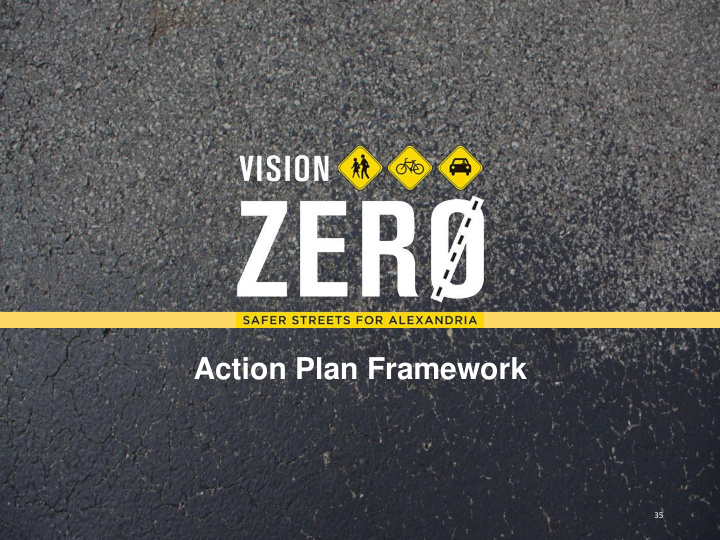



Action Plan Framework 35
Background Adopted Pedestrian & Bicycle Master Plan – Spring 2016 • Key strategy: Evaluate traffic deaths and develop a Vision Zero program that outlines the framework and necessary resources Drafted Vision Zero Resolution - Summer/Fall 2016 • Worked with subcommittee to develop policy resolution and build support and receive feedback from Boards & Commissions Adopted Vision Zero Policy – January 2017 • Resolution endorsed by Transportation Commission and adopted by City Council • Goal: Zero traffic deaths and serious injuries by 2028. • Directs staff to build action plan – the road map to achieve Vision Zero 36
What is Vision Zero? A multi-national traffic safety project that aims to achieve a transportation system with zero deaths or serious injuries. • Multidisciplinary approach to rethinking traffic safety • Recognize traffic deaths and serious injuries are preventable • Sets aggressive timeline to eliminate both • Strategic and measurable goals • Data-driven 37
Action Plan Timeline • Form interdepartmental work group – Feb 2017 Partner Agencies • Transportation & Environmental Services • Review existing program, policies and plans – May 2017 • Alexandria Police Department • Alexandria Fire Department • General Services – Fleet Management • Extensive community engagement effort – May 2017 • Commonwealth Attorney’s Office • Health Department • Geographical Information Services • Complete comprehensive crash analysis – July 2017 • DASH • Office of Human Rights • City Manager’s Office • Identify applicable data-driven best practices – July 2017 • Recreation, Parks, & Cultural Activities • Office of Performance & Accountability • Office of Communications & Public Information • Draft Action Plan for public review – Summer/Fall 2017 • Planning & Zoning • Transportation Commission (Public Hearing) – December 2017 • Adoption by City Council (Public Hearing) – December 2017 / January 2018 38
Public Involvement Overview Purpose : • Increase awareness of the Vision Zero concept, existing policy, and activities • Gain insight into the public’s safety issue areas, biggest concerns, and priorities for transportation safety Approach: • Engage a wide segment of the community to reflect the diversity of the City’s residents and visitors Event Format: • Street Meetings • Old Town Farmers Market/ Metro Station/ Mark Center/ West End/ Arlandria / TC Williams HS • 467 people engaged • Online Survey • 560 participants 39
Public Involvement – Key Findings Top 3 Challenges to Safely Moving Around Alexandria 1. Districted drivers 2. Speeding 3. People running red lights of stop signs Over 16% of Participants had experienced or knew someone that was seriously injured or died in a crash. Primary factor reported were (in order) 1. Districted drivers 2. Speeding 3. People running red lights of stop signs 40
Public Involvement – Wikimap • 676 comments • Key Findings: • Speeding • Drivers fail to yield / run stop lights and signs • Need improved pedestrian infrastructure • Poor accessibility due to sidewalk and other infrastructure conditions • Confusing traffic patterns • To be compared with KSI* spatial data * KSI = Killed or Seriously Injured 41
KSI Analysis* - Overview Dataset • APD crash data CY 2011-2016 Methodology 1) Descriptive exploration 2) Statistical analysis (significance test, logit models) Limitations • Quality and quantity of crash reports * KSI = Killed or Seriously Injured 42
Data Trends 1. Risk has dropped since 2011 2. Risk is elevated during certain times of day and seasons 3. Corridors with elevated risks 4. Environmental (weather, lighting, and road) conditions elevate risk 5. Certain street design characteristics impact KSI risks 6. Increased speed increases KSI risks 7. Pedestrians are particularly vulnerable road users. 8. Motorcyclists are particularly vulnerable road users . 9. The young and old have distinct KSI risks 10.Poor choices (lack of safety restraint or drinking) increase KSI risks 43
KSI Risk has dropped since 2011
Increased Speed Elevates KSI Risk
Pedestrians are More Vulnerable
Action Plan Organization 1. Why is Vision Zero needed? 2. How was the Action Plan developed? 3. How will we achieve Vision Zero? 4. What will it take to achieve Vision Zero? 5. How will we measure success? 47
Strategy Development Drafted strategies based on: • KSI Analysis Key Findings • Public Involvement • Review of Existing Programs, Policies and Plans • Input from Work Group • Review of Data-Driven Best Practices • Vision Zero Network Key Principles
Strategy Themes 1. Build Safe Streets for Everyone [Engineering] 2. Promote Culture of Safety [Education & Enforcement] 3. Enhance City Processes & Collaboration [Administrative & Policy] 4. Improve Data Collection [Evaluation]
Next Steps • Finalize draft for public comment period – Late October 2017 • Public comment period – Late October / November 2017 • Present draft Action Plan for Transportation Commission for endorsement (public hearing) – December 2017 • Present Action Plan to City Council for approval (public hearing) – December 2017 / January 2018
Questions / Contact Info Project Manager Ray Hayhurst, Acting Complete Streets Program Manager Raymond.Hayhurst@alexandriava.gov www.alexandriava.gov/VisionZero 51
Recommend
More recommend